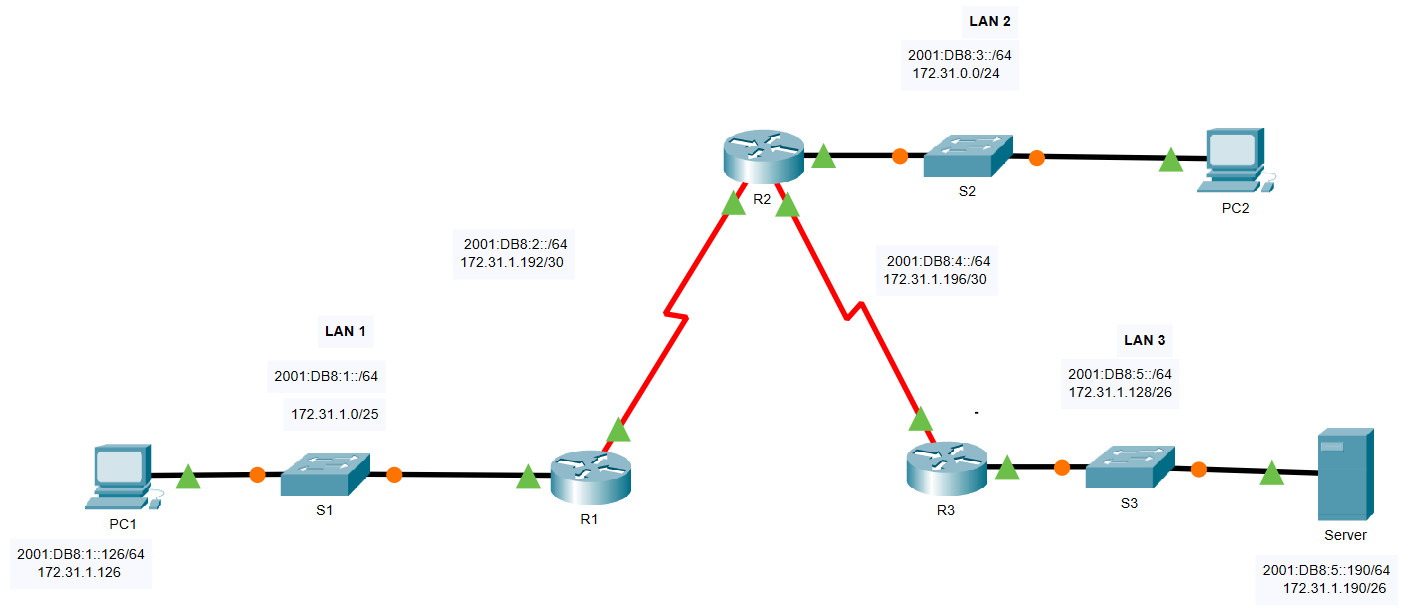16.3.1 Packet Tracer – Troubleshoot Static and Default Routes (Instructor Version)

16.3.1 Packet Tracer – Troubleshoot Static and Default Routes
Addressing Table
| Device | Interface | IP Addresses |
|---|---|---|
| R1 | G0/0 | 172.31.1.1/25 |
| 2001:DB8:1::1/64 | ||
| S0/0/0 | 172.31.1.194/30 | |
| 2001:DB8:2::194/64 | ||
| R2 | G0/0 | 172.31.0.1/24 |
| 2001:DB8:3::1/64 | ||
| S0/0/0 | 172.31.1.193/30 | |
| 2001:DB8:2::193/64 | ||
| S0/0/1 | 172.31.1.197/30 | |
| 2001:DB8:4::197/64 | ||
| R3 | G0/0 | 172.31.1.129/26 |
| 2001:DB8:5::1/64 | ||
| S0/0/1 | 172.31.1.198/30 | |
| 2001:DB8:4::198/64 | ||
| PC1 | NIC | 172.31.1.126/25 |
| 2001:DB8:1::126/64 | ||
| PC2 | NIC | 172.31.0.254/24 |
| 2001:DB8:3::254/64 | ||
| Server | NIC | 172.31.1.190/26 |
| 2001:DB8:5::190/64 |
Objectives
In this activity you will troubleshoot static and default routes and repair any errors that you find.
- Troubleshoot IPv4 static routes.
- Troubleshoot IPv4 default routes.
- Troubleshoot IPv6 static routes.
- Configure IPv4 static routes.
- Configure IPv4 default routes.
- Configure IPv6 static routes.
Background / Scenario
A newly hired network technician is attempting to preconfigure a simple topology that will be delivered to a customer. The technician has not been able to establish connectivity between the three LANs. You have been asked to troubleshoot the topology and verify connectivity between the hosts on the three LANs over IPv4 and IPv6.
Instructions
Step 1: Locate and document the problems.
Review the routing table on R1, R2, R3.
Record your findings in a table like the one below.
| Location | Problem | Solution |
|---|---|---|
| R1 | IPv4 Default route next hop interface address is incorrect. | Change next hop address to 172.31.1.193 |
| R2 | IPv6 route to LAN 1 has the wrong network address for the destination network. | Change destination address from 2001:DB6:1::/64 to 2001:DB8:1::/64 |
| R2 | The next hop addresses in the two IPv4 routes are reversed. | Change the statements to ip route 172.31.1.0 255.255.255.128 172.31.1.194 and ip route 172.31.1.128 255.255.255.192 172.31.1.198 |
| R3 | The IPv6 route to LAN 1 is missing. | Configure a directly connected static route to 2001:DB8:1::/64 |
| R3 | The IPv4 route to LAN 1 has the wrong mask for the network. | Change the mask to 255.255.255.128 |
Step 2: Repair the problems.
Configure the devices so that full connectivity exists between the hosts on the LANs over IPv4 and IPv6.
Note: Your task is to establish connectivity using the existing static route design. Changing the types of static routes used will result in a loss of points.
Answer Configurations
Router R1
enable conf t no ip route 0.0.0.0 0.0.0.0 172.31.1.195 ip route 0.0.0.0 0.0.0.0 172.31.1.193 end
Router R2
enable conf t no ip route 172.31.1.0 255.255.255.128 172.31.1.198 no ip route 172.31.1.128 255.255.255.192 172.31.1.194 ip route 172.31.1.0 255.255.255.128 172.31.1.194 ip route 172.31.1.128 255.255.255.192 172.31.1.198 no ipv6 route 2001:DB6:1::/64 2001:DB8:2::194 ipv6 route 2001:DB8:1::/64 2001:DB8:2::194 end
Router R3
enable conf t no ip route 172.31.1.0 255.255.255.240 Serial0/0/1 ip route 172.31.1.0 255.255.255.128 Serial0/0/1 ipv6 route 2001:DB8:1::/64 Serial0/0/1 end
